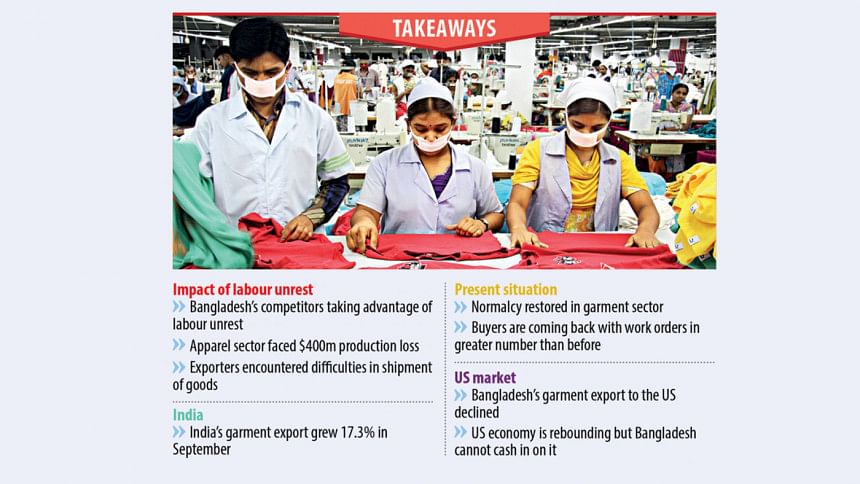Unrest erodes Bangladesh’s RMG edge over rivals

Garment exports by Bangladesh's market rivals like India, Vietnam, China and Cambodia have increased to major Western markets due mainly to the latest spell of labour unrest and political changeover earlier in August in the country.
In September, India's readymade garment (RMG) exports grew by 17.3 percent year-on-year, capitalising on political instability in Bangladesh, according to Indian daily The Telegraph.
The growth comes despite global challenges such as inflation and supply chain disruptions, which have impacted other major garment-exporting nations, the report states.
"India's RMG exports have recorded high growth despite global headwinds and inflationary pressures," said Sudhir Sekhri, chairman of the Apparel Export Promotion Council.
"Many leading apparel exporters have experienced a slowdown in recent months, but India has benefitted from Bangladesh's socio-political unrest," he added.
Bangladesh's internal turmoil forced some factories to close temporarily, causing delays in delivery schedules.
Referring to India's CareRatings, The Telegraph also said if the unrest continues for more than one or two quarters, Bangladeshi exporters could face significant challenges in meeting deadlines.
In the July-September period of the current fiscal year, Bangladesh's garment export grew 5.3 percent year on year to $9.28 billion, according to the Export Promotion Bureau (EPB).
Despite the EPB's growth count, apparel exports in the first eight months of 2024 to the US and European Union (EU) were not encouraging compared to Bangladesh's market competitors.
For instance, garment export to the USA, the country's main export destination, fell by 9.16 percent year-on-year to $4.70 billion in the January-August period of the current year, according to data from the Office of Textiles and Apparel (OTEXA).
OTEXA attributed the fall to slumping demand for apparels in the American market.
In combined, the textile and garment shipment from Bangladesh to the USA also fell by 8.98 percent year-on-year to $4.84 billion in the January-August period this year, showed the OTEXA data.
Bangladesh's competitors performed well in the USA and EU markets as data showed that their exports, in terms of quantity, increased. The countries also took the advantage of the rebounding US economy, as consumer spending on retail goods, including apparel items, increased.
The retail sales in the US increased again in September as employment grew and inflation and interest rates fell, said Jack Kleinhenz, chief economist of the National Retail Federation (NRF), the world's largest retail trade association.
In the January-August period, the quantity of apparel imported by the USA increased by 1.5 percent year-on-year, while Bangladesh's export declined by 3.8 percent in terms of quantity.
During the period, US apparel sourcing from China increased by 3.6 percent in terms of quantity.
Apparel exports to the USA by Vietnam during this period increased by 5.2 percent, from India by 7.6 percent and from Cambodia increased by 7.7 percent, according to OTEXA data compiled by the BGMEA.
Similarly, in the January-July period, garment imports by the EU countries increased by 3.3 percent and the growth was only 2.8 percent from Bangladesh, according to Eurostat data compiled by the BGMEA.
During this period, apparel export to the EU by China grew by 6.4 percent, from India at 5.18 percent, from Cambodia at 18.35 percent, from Vietnam at 12.61 percent and from Pakistan by 14.41 percent, showed the data.
Overall in the July-September period, garment export from Bangladesh grew by 5.34 percent, whereas Vietnam recorded the overall apparel export growth at 15.57 percent and India at 13.45 percent, the BGMEA compiled data showed.
The data analysis showed that the garment exports by other countries grew faster than Bangladesh in the major markets largely because of the political and labour unrest.
The local garment exporters could not produce goods smoothly and ship those on time.
Exporters said some of the international retailers and brands either suspended their factory visit or shifted work orders to other countries.
A good number of garment factories have witnessed on and off situations since the beginning of the anti-discriminatory student movement in mid-July this year.
AK Azad, chairman and managing director of Ha-Meem Group, which mainly exports to the USA, said he experienced labour unrest and his export was affected like others.
"However, now I have been booking a lot of work orders from the buyer as they are coming back for the next seasons," Azad said.
Ex-president of now dissolved Bangladesh Garment Manufacturers and Exporters Association (BGMEA) Khandoker Rafiqul Islam also echoed Azad, saying, "Buyers are coming back now as the normalcy has restored in the sector."

 For all latest news, follow The Daily Star's Google News channel.
For all latest news, follow The Daily Star's Google News channel. 







Comments